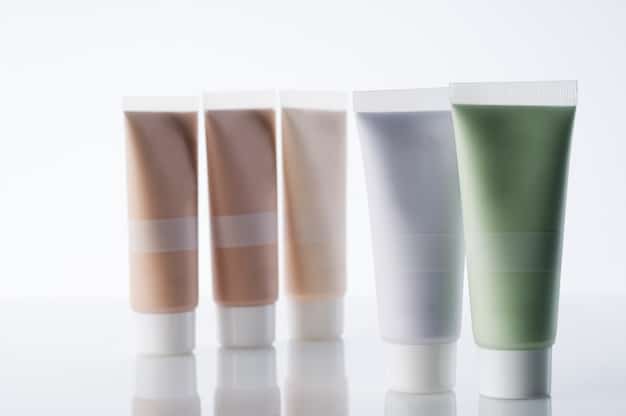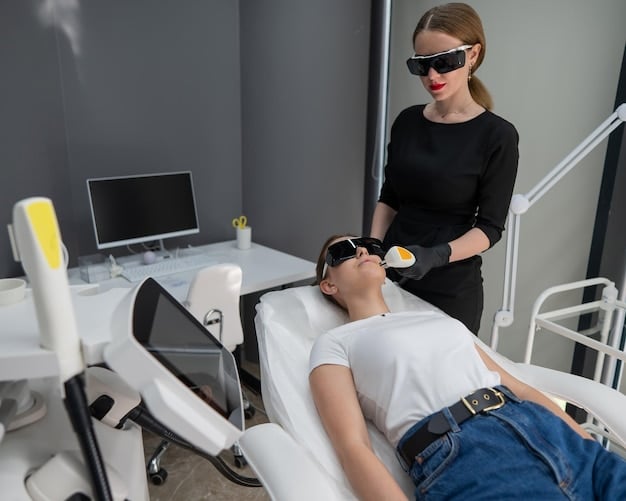Acne-Prone Skin? Your 2025 Guide to a Simplified, Clearer Routine

Advertisements
Navigating acne-prone skin in 2025 involves a simplified routine focusing on gentle cleansing, targeted treatments, hydration, and sun protection. This guide provides an updated and streamlined approach to achieving a clearer complexion.
Advertisements
Do you struggle with acne-prone skin? The 2025 Guide to a Clearer Complexion with a Simplified Routine is here to help. Adapting your skincare doesn’t need to be complicated!
Understanding Acne-Prone Skin in 2025
Acne-prone skin can feel like a constant battle, but understanding its nuances is the first step towards managing it effectively. In 2025, we have access to a wealth of information and advanced products designed to target acne at its source.
What Causes Acne?
Advertisements
Acne forms when hair follicles become clogged with oil and dead skin cells. Bacteria, particularly Cutibacterium acnes (formerly known as Propionibacterium acnes), can then thrive in these clogged follicles, leading to inflammation and breakouts.
Factors Contributing to Acne
Several factors can contribute to acne, including hormonal fluctuations (especially during puberty, menstruation, or pregnancy), genetics, certain medications, and even stress. Diet, while often debated, can also play a role for some individuals.
- Hormones: Androgen hormones increase oil production, leading to clogged pores.
- Genetics: A family history of acne can increase your likelihood of developing it.
- Cosmetics: Certain makeup and skincare products can clog pores. Look for non-comedogenic options.
- Stress: Stress can trigger hormonal changes, exacerbating acne.
Understanding these underlying causes can help you tailor a skincare routine that addresses your specific needs. The key is to identify your triggers and choose products and practices that support your skin’s natural balance.
By understanding what makes your skin prone to acne, you can start to build a targeted routine that will reduce breakouts without damaging the delicate skin. Remember, consistency is key!
The Simplified Skincare Routine for Acne-Prone Skin
A complicated skincare routine with too many steps and harsh ingredients can often worsen acne. The 2025 approach emphasizes simplicity and gentleness, focusing on the essentials that support skin health and reduce breakouts.
Step 1: Gentle Cleansing
Cleansing is the foundation of any skincare routine. For acne-prone skin, a gentle cleanser is crucial. Avoid harsh soaps and scrubs, which can strip the skin of its natural oils and lead to irritation and inflammation.
Look for cleansers that are fragrance-free, non-comedogenic, and contain ingredients like salicylic acid or benzoyl peroxide in low concentrations. These ingredients help to exfoliate the skin and kill acne-causing bacteria without being overly drying.
Step 2: Targeted Treatments
Targeted treatments address specific acne concerns. Common ingredients include:
- Salicylic Acid: Exfoliates the skin and unclogs pores.
- Benzoyl Peroxide: Kills acne-causing bacteria.
- Retinoids: Promote cell turnover and prevent clogged pores.
- Azelaic Acid: Reduces inflammation and hyperpigmentation.
When using targeted treatments, start slowly and increase frequency as tolerated. Overuse can lead to dryness, irritation, and even more breakouts. It’s often best to consult with a dermatologist to determine the right treatment and concentration for your skin.

Remember, consistency is key. Stick to your routine, even when your skin looks clear, to prevent future breakouts.
The Importance of Hydration and Sun Protection
Many people with acne-prone skin mistakenly believe that they don’t need to moisturize. However, hydration is essential for maintaining healthy skin and preventing overproduction of oil. Sun protection is equally important, as some acne treatments can make the skin more sensitive to the sun.
Hydration: Finding the Right Moisturizer
Choose a lightweight, non-comedogenic moisturizer that won’t clog pores. Look for ingredients like hyaluronic acid, glycerin, or ceramides, which help to hydrate and strengthen the skin barrier.
Sun Protection: Protecting Sensitive Skin
Sunscreen is a non-negotiable part of any skincare routine, especially for acne-prone skin. Choose a broad-spectrum sunscreen with an SPF of 30 or higher. Mineral sunscreens containing zinc oxide or titanium dioxide are often a good choice, as they are less likely to cause irritation.
Apply sunscreen liberally and reapply every two hours, especially if you’re sweating or swimming. Protecting your skin from the sun not only prevents sun damage but also helps to minimize post-inflammatory hyperpigmentation (PIH), the dark spots that can linger after acne heals.
Hydration and sun protection are crucial for healthy skin, even when you are prone to acne. Don’t skip these steps!
Lifestyle Factors That Impact Acne
While skincare is crucial, lifestyle factors also play a significant role in the health of your skin. Diet, stress, sleep, and exercise can all impact acne, either positively or negatively.
Diet and Acne
While the link between diet and acne is complex, some studies suggest that certain foods can exacerbate breakouts. High-glycemic foods, dairy, and processed foods may trigger inflammation and increase oil production in some individuals.
Stress Management
Stress can wreak havoc on your skin. When you’re stressed, your body releases hormones like cortisol, which can increase oil production and inflammation. Finding healthy ways to manage stress is essential for clear skin.
Consider incorporating stress-reducing activities into your routine, such as:
- Meditation: Even a few minutes of daily meditation can help to calm your mind and reduce stress.
- Exercise: Physical activity is a great way to release tension and improve overall well-being.
- Yoga: Combines physical activity with mindfulness, promoting relaxation and stress reduction.
- Spending Time in Nature: Being outdoors can have a calming effect and reduce stress levels.
Sleep and Exercise
Getting enough sleep is crucial for skin health. During sleep, your body repairs and regenerates cells. Aim for 7-9 hours of quality sleep each night. Regular exercise can also improve circulation and reduce inflammation, contributing to clearer skin.
Small changes to your lifestyle might deliver unexpected but meaningful results in reducing your acne symptoms.
Advanced Treatments and Technologies for Acne in 2025
Beyond basic skincare, advanced treatments and technologies can offer additional benefits for acne-prone skin. In 2025, we see even more innovative approaches to managing acne, from laser therapies to personalized skincare solutions.
Laser and Light Therapies
Laser and light therapies can target acne-causing bacteria, reduce inflammation, and improve skin texture. Common treatments include blue light therapy, red light therapy, and pulsed dye laser (PDL). These treatments are often performed in a dermatologist’s office.
Chemical Peels
Chemical peels involve applying a chemical solution to the skin to exfoliate and remove dead skin cells. They can be effective for treating acne, reducing inflammation, and improving skin tone and texture. Common peels for acne include salicylic acid peels, glycolic acid peels, and TCA peels.
Personalized Skincare
In 2025, personalized skincare is becoming increasingly popular. This approach involves analyzing your skin’s unique characteristics and creating a customized skincare routine based on your specific needs. Many companies now offer at-home DNA tests or online consultations to tailor skincare products to your skin type and concerns.

Exploring advanced treatments may be worth it and consulting with a dermatologist is a step in the right direction. Technology is constantly advancing and can help provide acne relief.
Common Mistakes to Avoid with Acne-Prone Skin
Even with the best intentions, certain habits and practices can sabotage your efforts to achieve clear skin. Here are some common mistakes to avoid when dealing with acne-prone skin.
Over-Exfoliating
While exfoliation can help to unclog pores and remove dead skin cells, over-exfoliating can irritate and inflame the skin, leading to more breakouts. Limit exfoliation to 1-2 times per week and use a gentle exfoliator.
Picking and Popping
Picking and popping pimples can cause inflammation, scarring, and infection. Resist the urge to squeeze blemishes. Instead, use targeted treatments to reduce inflammation and promote healing.
Using Harsh Products
Harsh soaps, scrubs, and astringents can strip the skin of its natural oils, leading to dryness and irritation. Choose gentle, fragrance-free products that are specifically formulated for sensitive skin.
Inconsistent Routine
Consistency is key when it comes to skincare. Skipping steps or using products sporadically can prevent you from seeing results. Stick to your routine, even when your skin looks clear, to prevent future breakouts.
Avoid making these common mistakes and adjust your skincare routine to support your skin needs. Listen to your skin’s reactions.
| Key Point | Brief Description |
|---|---|
| 🧼 Gentle Cleansing | Use a mild, fragrance-free cleanser to avoid irritation. |
| 🎯 Targeted Treatments | Start with low concentrations of salicylic acid or benzoyl peroxide. |
| 💧 Hydration | Opt for lightweight, non-comedogenic moisturizers. |
| ☀️ Sun Protection | Apply broad-spectrum mineral sunscreen daily. |
Frequently Asked Questions
▼
Avoid products containing alcohol, fragrances, and heavy oils, as these can irritate and clog pores. Always check the label for comedogenic ingredients before trying new products.
▼
Wash your face twice a day, morning and night, to remove excess oil and impurities. Overwashing can strip the skin and lead to increased oil production, so moderation is key.
▼
Yes, certain makeup products can clog pores and contribute to acne. Choose non-comedogenic and oil-free makeup options, and always remove your makeup before going to bed.
▼
It typically takes 4-6 weeks to see noticeable improvements in your skin. Be patient and consistent with your routine, and don’t get discouraged if you don’t see results immediately.
▼
If your acne is severe, persistent, or causing scarring, it’s best to consult with a dermatologist. They can provide personalized treatment options and address any underlying skin concerns.
Conclusion
Achieving clearer skin with acne-prone skin? The 2025 Guide to a Clearer Complexion with a Simplified Routine involves a combination of a gentle skincare routine, a few lifestyle adjustments, and, if necessary, advanced treatments under the guidance of a dermatologist. By focusing on simplicity, consistency, and the overall health of your skin, you can take control and achieve a complexion that makes you feel confident and comfortable.





